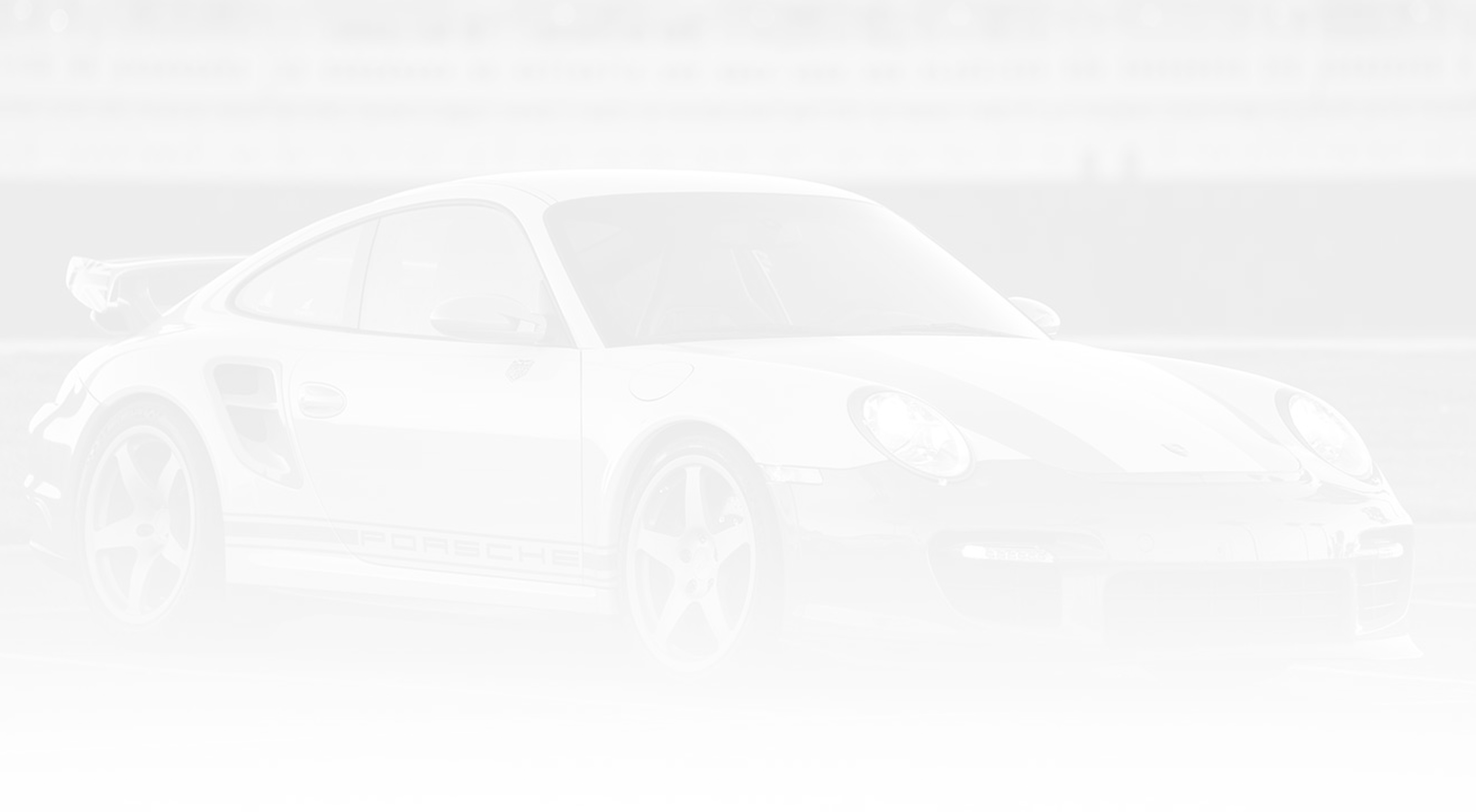SharkWerks 997.2 Modification and Tuning Guide
for 2009-2012 DFI Carrera / S / 4 / 4S / GTS Models
In 2009, the Porsche 911 had a major makeover. While it may look similar at a glance to the 2008 997 model, it actually had a number of improvements including a completely new engine (the direct injection 9A1), optional PDK transmission, updated PCM (communications system, e.g. stereo) and revised suspension. In particular, the new engine became the building block for all of Porsche's 911/Cayman/Boxster engines going forward- even the 997.2 Turbo for that matter. No longer hampered by intermediate shaft failures or oil-starvation issues when pushed hard, this new 911 is much better equipped for more advanced/aggressive driving at the track than the generation 1 997 (2005-2008) with its M97 block.
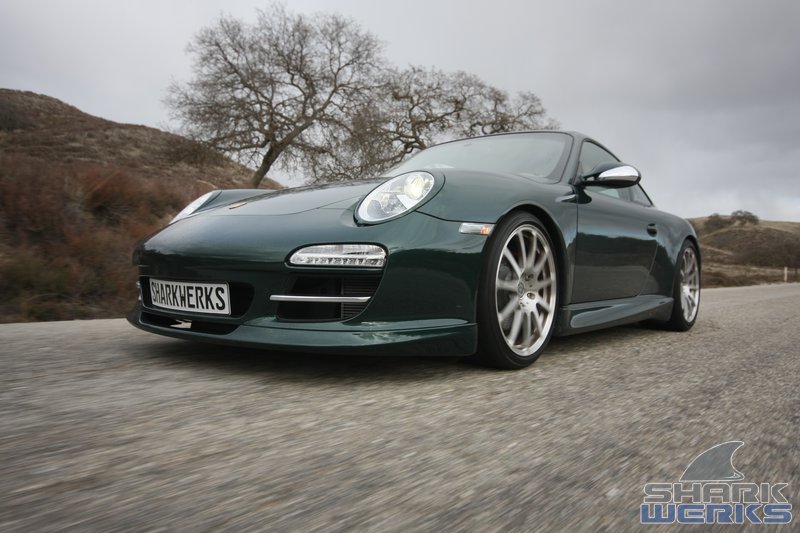
In order to familiarize ourselves with this new car, we acquired the first day it became available in the United States, and dubbed this project "ZTADPOLE". Over the next two years, we tinkered and tuned every inch of the car to further optimize what Porsche had done from the factory. And while this car was a massive improvement over the previous generation, in stock form the car tends to be a bit too soft, quiet and well, boring for some people.
We are often asked "What would you do if this was your car?" While there isn't really a correct answer for every person and situation, and this isn't meant to be an "Official FAQ", it is our guide to playing/experimenting with your 997.2 based upon our experiences having owned, driven and worked with these cars over the years.
Out of the box, this is a great and balanced car with no shortcomings or reliability concerns. It's nearly as fast as the Turbo models from a few years back with better handling. The PDK is fantastic. Surely it's enough car for most people, but Porsche did leave a bit on the table and our goal with buying this car was to find out where those tweaks could be made. If you want more horsepower, sharper handling, a more exciting exhaust note, or just a bit more fun, read on to see what we recommend for these cars.
Factory Porsche OEM Upgrades
The most important option available for these cars is the Sport Chrono Package. This allows the "Sport" mode on manual cars and "Sport Plus" when using the PDK transmission. Without Sport mode, the PDK is a bit lazy, especially compared to Sport Plus with its lightning-fast shifts. Sport mode also allows higher ignition maps with more timing, for slightly more horsepower and sharper throttle response. With our tuning options, we can further modify all of these modes (see below for ECU tuning), but with the PDK transmission, Sport Chrono is a must-have option if you really want to squeeze the most from the car, and it can be retrofitted to cars without it, although only at Porsche dealerships.
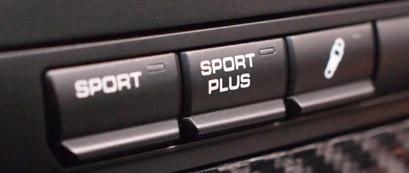
There is also a highly desirable factory exhaust option (PSE or Porsche Sport Exhaust), mostly only found on 2010 and newer cars (PSE was delayed on most of the 2009 year cars), which allows you to switch the side mufflers from a quiet to louder mode at the click of an exhaust button. This is also compatible with aftermarket exhaust sections mentioned below.
The cars can be fitted with PCCB brakes as a factory option (at the price of about $8000), and this is a highly-desired option for non-track use. It is rather rare on the non-Turbo and non-GT3 cars.
Carrera S' come standard with PASM while it's an option on the Carrera. Beyond that some cars that have the optional Sport suspension (called Sport PASM). It gives a slightly lower ride height and active shocks, which can be switched from soft to hard modes (for smooth roads and race-like hardness) with the click of a button in front of the shifter.
GTS models were also sometimes optioned with the Centerlock wheels (as opposed to 5-lug), which limits the brake and wheel upgrades available for the car. Some owners insist on switching these to the standard 5-lug wheel layout and this can be done through Porsche, although it's very expensive.
Exhaust
The exhaust is the same on all 997 Carrera, S, 4, 4S, and GTS models with the only option being the PSE mentioned in this article. After the headers (A), the exhaust enters a single center muffler (B) then flows into two large side mufflers (C), and exits through the tailpipes at either side of the rear bumper.
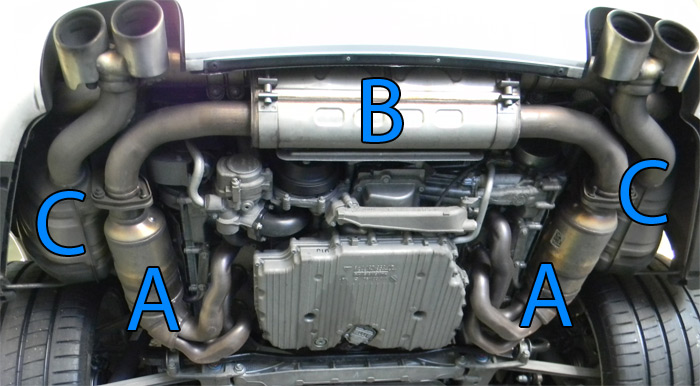
The exhaust is notoriously quiet, with many owners stating this is their primary complaint about the car. It is the quietest 911 to date, with the peppiest engine, making it feel more like a luxury car than a sports car. Luckily its three-muffler design makes it easier to modify than previous 911s.
If you are new to the aftermarket exhaust options available for these cars, we highly recommend you visit local "Cars and Coffee" type events, race tracks and performance shops to hear the different systems in person. No video or description can ever replace the first hand experience of hearing it for yourself.
Most people want something louder that sounds good, but these are subjective terms. Generally we do not outfit these cars with something that's too loud, obnoxious or problematic. Hearing a car in person instead of over PC speakers can help you determine your ideal exhaust solution, this is simply our take.
Muffler Bypass
We quickly discovered that you can bypass one or two of the three mufflers to change the nature of this car, and tried several combination of designs and pipes to make the most of existing stock components.
There are three such designs commonly sold for these cars:
Side muffler bypass, or bypassing the two side mufflers and retaining the single center muffler. In theory this sounds ideal, as it would most significantly reduce the weight off the car's rear. The side mufflers weigh approximately 34 pounds combined. However, the downside is obvious when you attempt to bypass these mufflers: the exhaust is simply too loud. For most people it would be considered obnoxiously so; it resonates at freeway speeds, with headache-inducing drone. It does not sound crisp (or good in our opinion) -- it's just loud. The center muffler alone is not enough to quiet the car to reasonable levels for street use.
Center muffler X-merge bypass, or replacing the first (center) muffler with straight-through tubing and combining the two sides to an "X", then using the side mufflers as originally designed. This was our first design and while it looked nice, it actually did not make the car much louder than stock. It also creates a bottleneck in the exhaust flow. No matter how well these "X-intersections" flow, they will never outflow two independent, mandrel-bent tubes. This explains the quieter tone and would probably result in less horsepower than the latter idea.
Center muffler independent bypass, or replacing the center muffler with straight-through mandrel bent tubes and using the side mufflers as originally designed. When we tried this design we were rather pleased with the result. Porsche designed the center muffler to keep both exhaust banks independent, and this design keeps that feature. It outflows the X-design, and it is not as loud as the side muffler bypass. It also has the nice feature of working with the PSE exhaust, since the only difference is in the side mufflers.
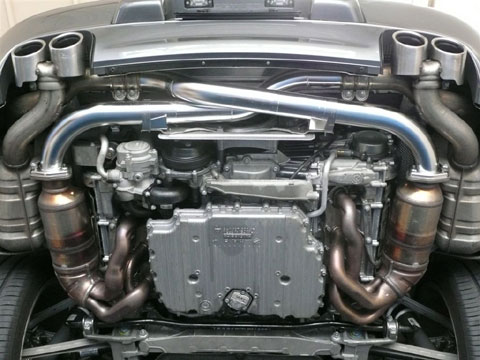
The result:
We tested our final prototype on an independent dyno in northern California, and were shocked to see our Carrera S picked up an additional 12 HP measured at the wheels (in 4WD mode no less!). When you cut apart the original center muffler, you can see why: the stock muffler makes two tight radius U-turn bends before exiting to the side mufflers. One nice feature of this exhaust is it only takes about 1-hour to install.

The stock center muffler cut-away
Since the factory catalytic converters and side mufflers are retained, the back pressure is not impacted enough to justify re-tuning the ECU. No torque is lost in the process with no ill-effects or check engine lights.
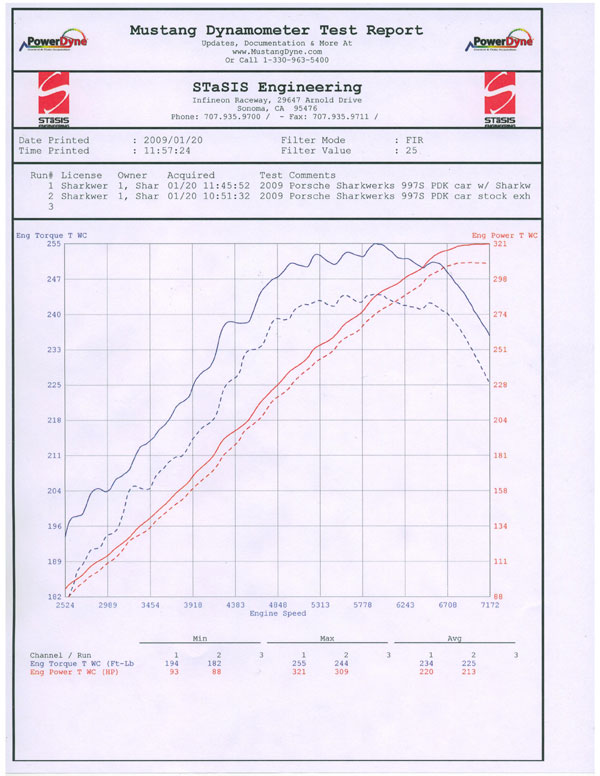
The design offers a sporty sound when compared to stock, almost like the PSE-exhaust. If you were to ask us on a scale of 1-10, we would rate the stock exhaust as a "4 out of 10", and the center bypass as "5 out of 10" at idle and cruising speeds and a "6 out of 10" under wide open throttle. It's the easiest, cheapest and only way to get a little more sound out of the car without upgrading to the PSE or risking changing the side mufflers (which can be too loud for some people). If you decide to switch to the PSE or side mufflers later, the pipe would work with these options as well.
For more information on our center bypass and videos, please click here.
PSE - Porsche Sport Exhaust
The Porsche Sport Exhaust was a factory option on 2010 and newer models and comes standard on the GTS models. Pressing the button partially bypasses the side mufflers, giving a much throatier and aggressive sound compared to the standard mode. If your car did not come with this exhaust, you can still buy it aftermarket through a Porsche dealership. It is quite expensive though -- expect to spend in the range of $4000-$5000 after installation and parts. We recommend trying our bypass or the Tubi exhaust before spending this much money on an exhaust.
Our center bypass is also compatible with the Porsche Sport Exhaust. It gives the car a deeper tone at idle and makes the Sport mode sound even more aggressive:
Side Muffler Replacement
We've tried and heard nearly every brand available on the market and we always come back to one in particular that hits it every time. Tubi Style systems are fine-tuned for the best sound possible, with high quality construction and perfect fitment. Tubi systems are known to have an exotic tone that turns heads, and are reasonable for daily driving and freeway cruising speeds.
The PSE with center bypass is close to the same sound ("7 out of 10" versus "8 out of 10"), but not quite as exciting or raspy. Sound is the primary reason we would recommend changing the exhaust, but the Tubi would likely see a further bump in horsepower, and of course reduced weight in the neighborhood of 20 pounds.
We don't recommend other brands for these cars. The common issues with other brands tend to be fitment, quality and tone. Some brands we have tested require grinding or hammering, prying and pushing to install on the car. Some have welds that crack after 10,000 miles. Some just sound bad. Most are too loud, causing drone at freeway speeds, resulting in headaches and rattling interior panels.
The Tubi does none of these wrong, it always works well so we recommend it nearly 100% of the time. You can also upgrade to the Tubi side mufflers (or any OEM-fitting side muffler replacements) and use our bypass exhaust in combination, assuming they fit with the stock center muffler. The Tubi does allow this, for example.
Muffler Modification
Some owners have had luck modifying the OEM side mufflers, and if done right this can result in a nice sound, but a bit louder than the standard system with our bypass. However it's also a rather major modification involving the removal of the side mufflers, then cutting and welding to the stock pipes.
We have not tested this modification for drone/resonance or long term reliability.
Headers & Catalytic Converters
The headers and catalytic converters on the 997.2 cars are welded together and are an improvement over previous 997 models. Many owners and tuners attempt to change this critical emissions equipment in order to gain a few horsepower. Could it be better/improved? Certainly, but at what cost and drawbacks? You'll be changing heat ranges the ECU reads, not to mention back pressure. All of these have an impact on what ignition maps your ECU calls for which can negatively affect power and drivability. Freer flowing headers sound good on paper but we usually see a low-end torque loss and in some cases a loss of power. Back pressure drops on a naturally aspirated engine do not produce the same level of gains/advantages as on a turbo engine. Since the headers and cats are a single piece on these cars, the oxygen sensors that provide the ECU with data can't just be moved around or ignored, either. They're vital to how the car will actually run and although you can make more power with less dense catalysts (200 cell versus 400 cell for example), we have seen many aftermarket cats break-down, come apart and fail. A check engine light is to be expected (even without visible failures) and something one should be prepared to face with this direction. The overall volume of sound will also increase.
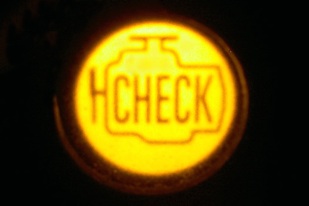
Considering the trouble-free, affordable and relatively easy ways to add nearly 20 HP to these cars, we do not recommend tinkering with the headers. You will likely find the persistent check engine light ruins the enjoyment of the car and you're taking a gamble to modify the most important part of the vehicle's emission equipment.
If you plan to change the headers/cats on your car, you should consult local and federal emissions regulations, as tampering with this equipment is not legal for street use in most regions.
Intake
Porsche left a bit on the table with the intake design on the 2005-2008 models, but the 2009+ have a much-improved design. For the MK2 they added a second inlet to allow for more cold air. We do not recommend changing the factory unit, as most designs on the market we have seen will allow hot, horsepower-robbing air to be sucked in from the engine bay. It causes the intake temperature to climb and forces the ECU to utilize lower maps for less HP. The OEM intake is designed to seal nicely against the decklid to provide cold outside air. It is not a major bottleneck in the car's powertrain and no aftermarket units we have tried proved to gain any horsepower on the dyno.
If you must tinker with your airbox we have used both the K&N and BMC filters in the past. We can't say you'll see/feel any difference but at least it does breathe better than a paper factory filter.
If you plan to change the intake air box on your car, you should consult local and federal emissions regulations, as tampering with this equipment is not legal for street use in most regions.
Software
Right from the get go we knew things were different with this 997. The DFI engine was controlled with a new Siemens SDI controller. We immediately teamed up with EVOMSit and set about R&D'ing a software tuning program for these cars. We were actually the first to offer tuning software by over a year having started a few months after our early September 2008 car became a donor for the process.
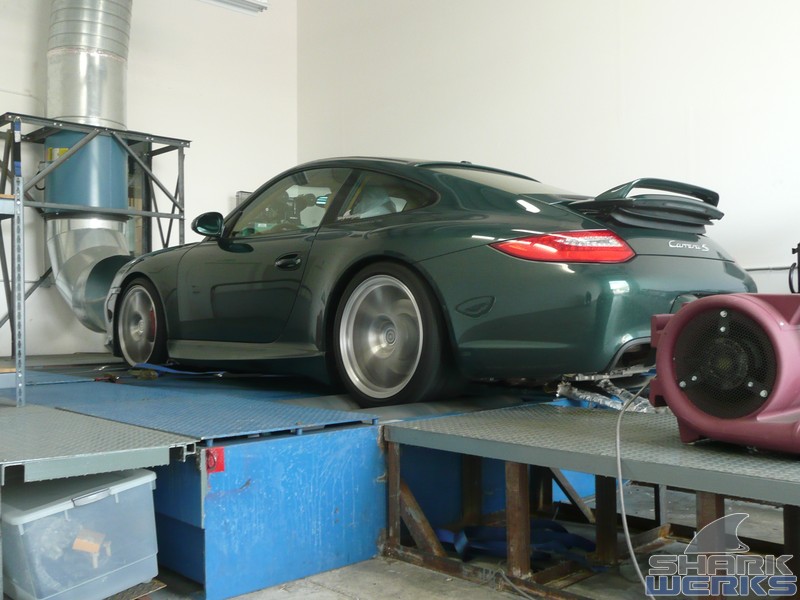
Once again a tremendous amount of time was spent fine tuning the software with 91 and 93 octane fuels.
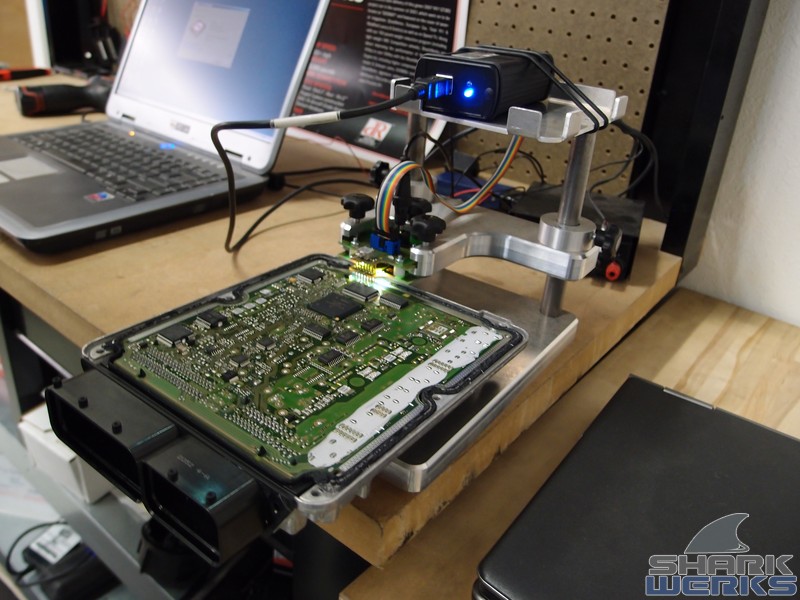
It's not just peak power but the drivability is also improved and much time was dedicated to the E-gas (electronic throttle pedal) settings which have been optimized in both sport and non sport modes. The improved throttle response in both modes provides a snappier throttle response as well as smoothing out some of the small dips. A solid 15+hp & 14tq is attainable. One can also customize some of the settings including adding in the ability to left-foot brake. The throttle body will no longer closed when touching the gas and brake simultaneously.
The OEM ECU features what we call IST (Intelligent Switching Technology) that allows for automatic switching of ignition timing maps based upon input received from other engine sensors. The EVOMSit ECU tuning utilizes the multiple OEM ignition tables in progressive stages, which can optimize safe performance based upon outside conditions and different octane fuels. The ECU automatically switches to the best-suited ignition map creating an automatic “race mode” if race fuel is utilized. We often get asked if is worth running better gas. The answer is always absolutely! The ECU even in stock form can take advantage of it. The process is simple as we send you an OBDII module that reads/wries to the car so no ECU removal is required. We also have put together a Shark Werks 997.2 bolt-on powerkit which indlues the exhaust, filters and ECU tune.
Not only are the power gains and overall performance impressive but we were able to improve the power while utilizing 91 octane fuel. All of our software upgrades utilize our IST (Integrated Switching Technology) and SP (Sport Pedal) functions. More info and dyno charts are available here:
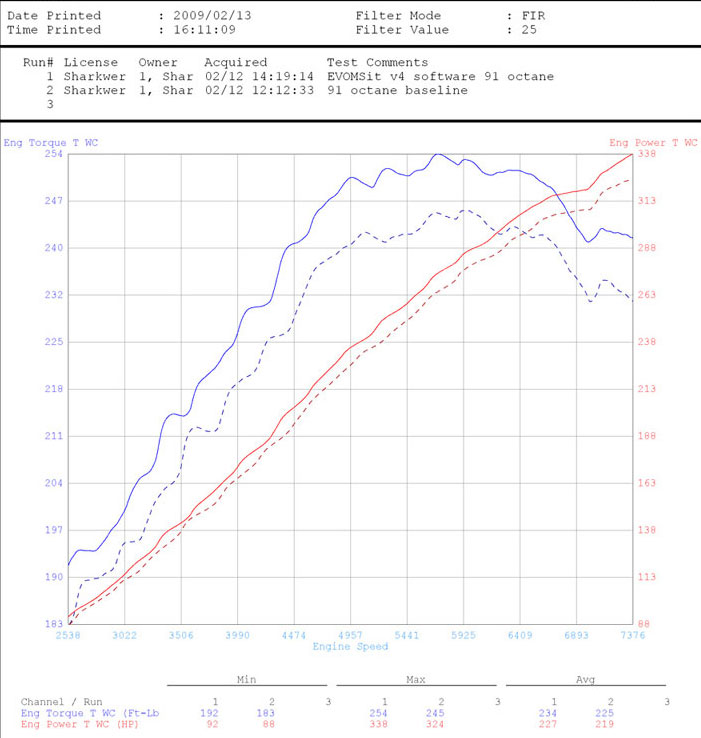
If you plan to modify the software on your car, you should consult local and federal emissions regulations, as tampering with this equipment is not legal for street use in most regions. Please read this page for more information.
Wheels
For 2009 Porsche did actually update some of their tired old wheel designs. Out with the horrid (no two ways about it) "lobster fork" wheels from the 997.1 and in with the sort of passable new sport designs and the like, although by today's standards they are certainly a bit on the heavy side.
One of the most striking ways to personalize a 997.2 is to give it a new pair of shoes as we like to say: a light-weight set of forged wheels can really transform how the car looks (and let's be honest and vane here). There are many forged wheel options out there so over the years we have bought and tested over rough Northen Californi roads and at the track that have held up over the years. We prefer to stick with our two long-standing partners (over 7.5 years) HRE and Champion Motorsport. Pick your flavor and go. There are many powder-coat options/finishes available so be sure to check-in on the gallery for examples. From HRE we'd recommend either the single piece Monoblok series or the motorsport-derived Competition series. We liked the HRE P43 wheel so much that ZTADPOL wore them with pride:
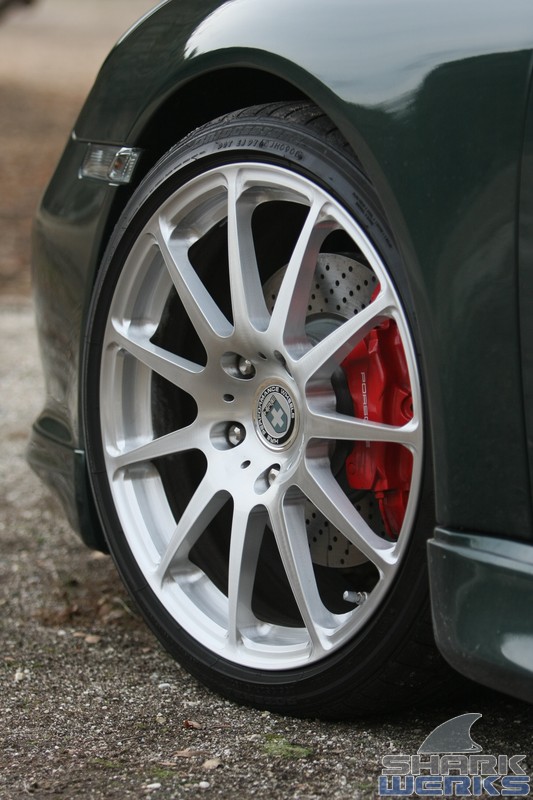
Our own 3.9L Kermit ran on 19 inch C-93s and Champion RS 171s at a later date. The later should _not_ be powdercoated as the manufacturer has concerns about metal fatigue/degradation. The HRE 3-piece competition series C-93 long-standing favorite being also light:
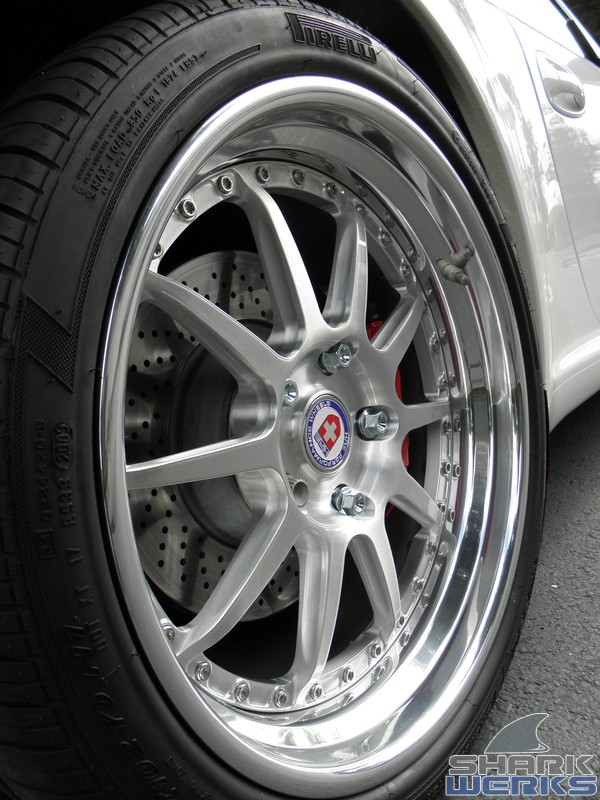
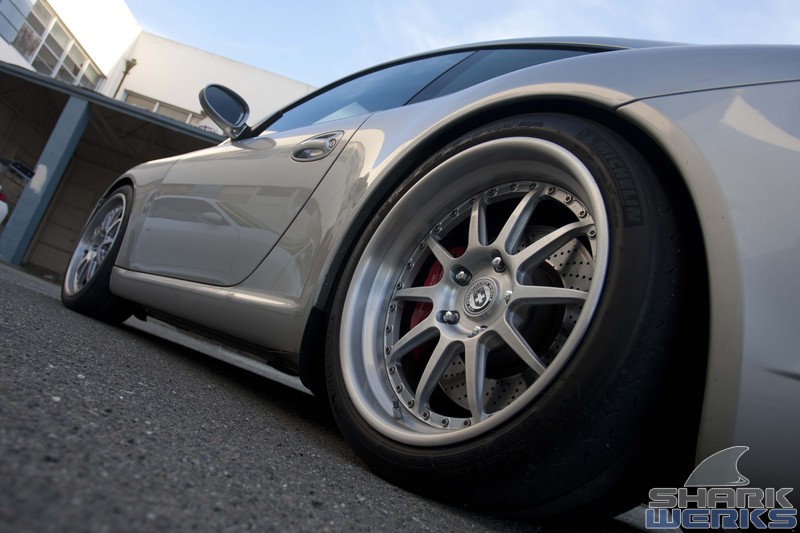
2007 997 GT3 Shown with HRE C-93 Wheels in brushed/clear finish
When building a custom wheel we tend to change the offsets to a more aggressive fitment negating the need for wheel spacers. Shown below is a classic-looking 5-spoke Champion RS-184 in 19 (again goes to show how many flavors there are). These days we use the HRE P305M which is much alike:
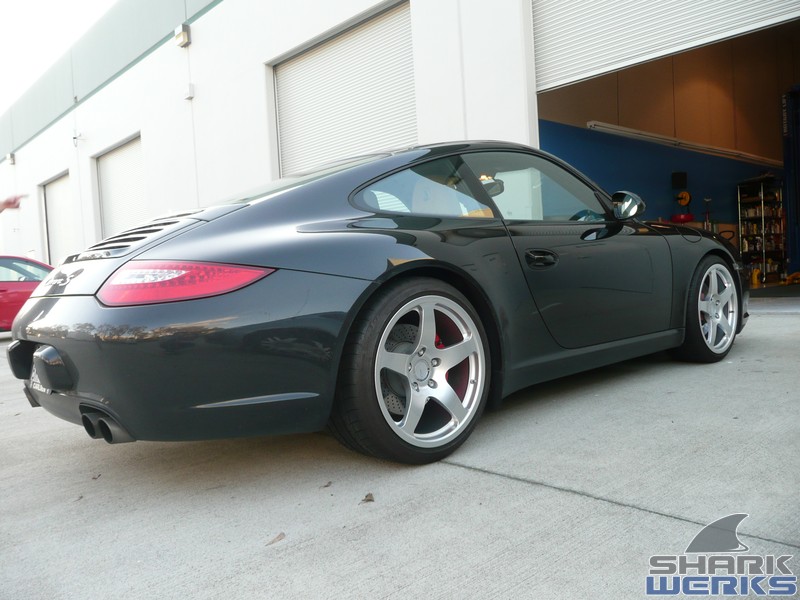
The more track-minded you are, the more likely you will end up with a second set of wheels. One set for the track and one for the street. To help make it easier / safer / faster to change wheels we like to use the High Strength Manganese Boron Steel RSS Wheel Stud kit to replace the lug nuts. A longer 90mm kit is also available. For those of us that drive the cars daily and/or in the rain, one set could be outfitted with a non R-compound tire such as the Michelin Pilot Super Sport. It tends to last longer as the tread-wear rating is considerably friendlier.
Want to go faster still and have an even better choice for race rubber? Then go with an 18-inch set up. Something like the HRE R40 race wheel which even fits over the PCCB caliper. It's both light and strong at 17-20 pounds and is currently used in real-world racing, rallying etc... The 18-inch wheel gives new options for tire choices. Current favorites nowadays seem to be the lightweight Forgeline GA1-R's , HRE P305M or HRE P101
Just say no to 20s. Get that idea out of your head. It won't look good. It won't ride well. The geometry and suspension was never set up for that sizing and we never put wheels larger than 19-inch diameter on the 997.2.
Spruce-up the Factory Wheels
Some of the more modern factory designed wheels look quite pleasing and with a few touches can really improve the overall appearance. Since all 997 models by law require enough space to utilize snow chains, the factory has to use very conservative offsets. This means the wheels are tucked in quite far into the fender. By using a set of front and rear spacers (we recommend 7mm front and 15mm rear) you can push those stock wheels out closer to the fender giving the wheel a more aggressive look. These come in either silver and/or black with correctly colored bolts. If you were to powdercoat your stock wheels black, example then a nice set of black bolts to go with black spacers would be best.
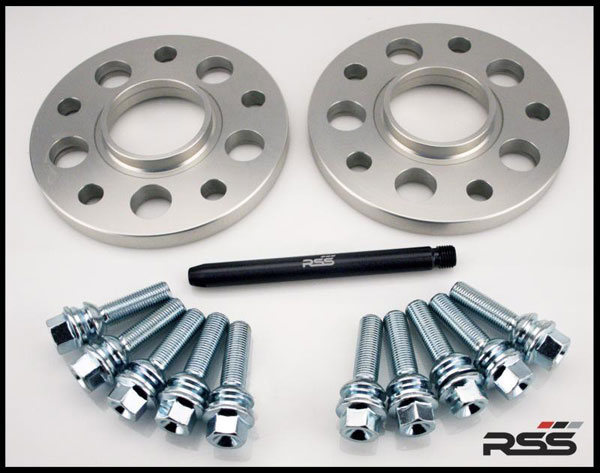
Brakes
Got steel brakes? Brilliant. Got PCCB's? Also bully for you (albeit with a slight twist). Trying to improve upon the factory system is like trying to take a top tier MMA fighter aside and saying, "I really like what you got and I need you to go more than 5 rounds". It's not something that's really necessary, nor is it easy to do. The factory brakes are world-class, make no bones about it. If you've come from any other Porsche wait till you put your foot into these -- especially PCCB's.
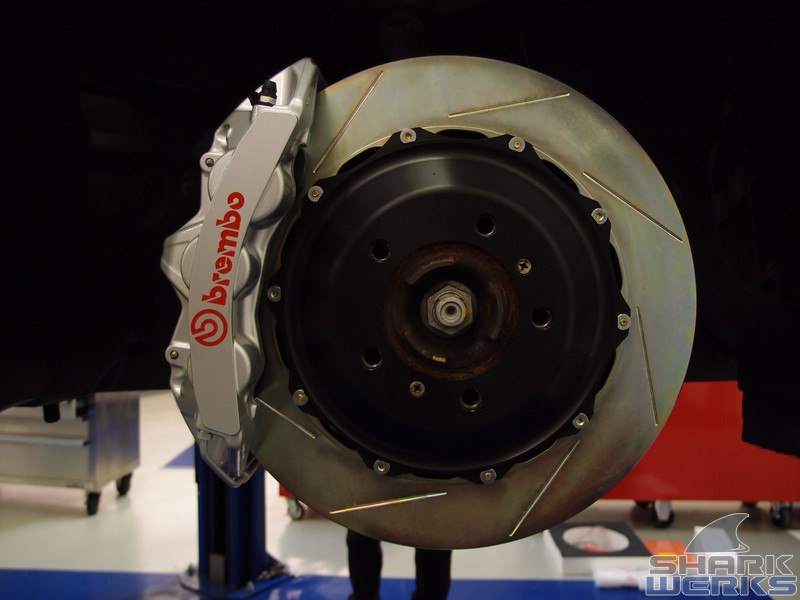
For a pure street car the PCCB's should be left alone. It's just not something one really needs to tamper with unless you're using the car extensively at the track. For steel brakes, you can certainly try running more aggressive pads but be prepared to change rotors (and induce even more noise) more frequently. When it does come time to change rotors a firm favorite is the two piece GiroDisc rotors which are not only a few pounds lighter but have better cooling properties thanks to their slotted design and an aluminum hat which you re-use.
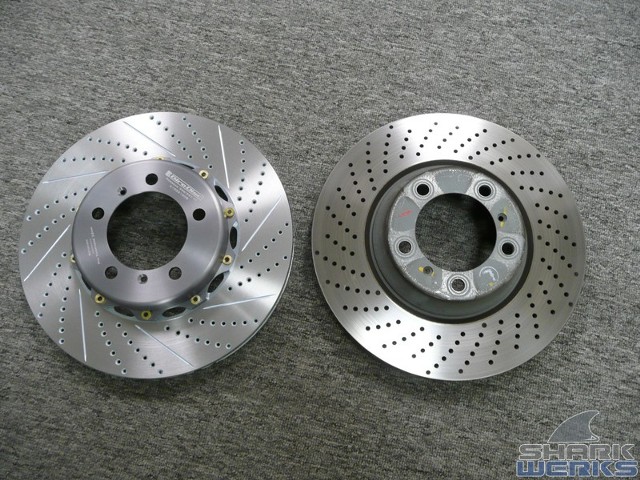
Over the years we've only seen a few cars with calipers start to fail and unless tracking regularly, upgrading the calipers seems unnecessary. If you need more stopping force, we recommend the Brembo GT system with great results. The 380mm front and rear kit can be set up with either drilled or slotted rotors. The rotors and calipers are lighter than the factory steel brakes and rotors.
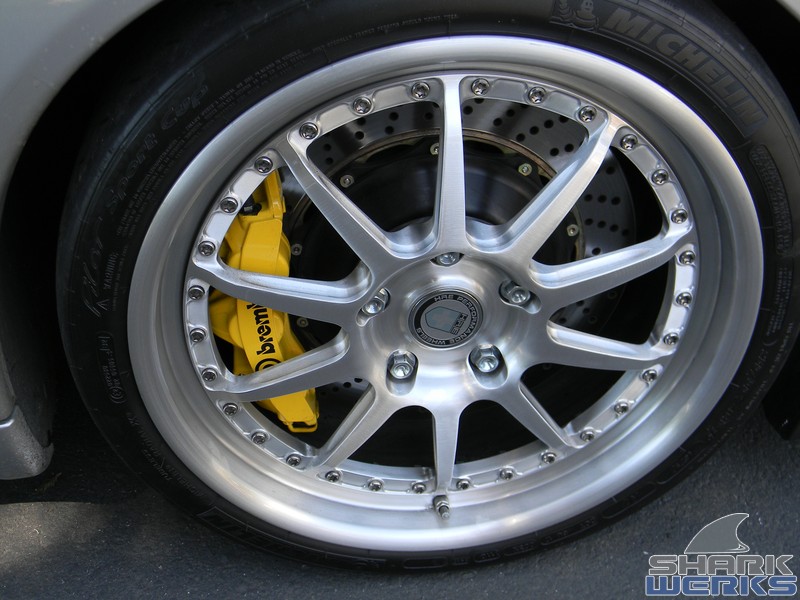
Tracking with PCCB's
It's generally not a great idea to use the PCCB's if you plan to track more than a few times a year or at medium/higher skill level. The rotors will simply not last long enough to be economically viable. Sadly that $8800 option is usually replaced with a $5000 two-piece steel rotor set up that we provide our track customers from Brembo. Their Type III rotor kit allows you to re-use those same yellow calipers in the front and rear but with 72-vein rotors (double that of standard) and intricate slots they've managed to survive well into a season even on higher HP turbocharged GT2 cars... let alone 997s. A superb option/alternative and the only draw back is the use of a narrow annulus brake pad in the front. Because you're no longer afraid of destroying your PCCB rotors you can opt for more aggressive brake pad combinations and replace just the outer rotors (retaining the aluminum hats) when needed for a much cheaper price than ceramic. In the field, this set up has been used for One Lap of America on GT3RS', Club Racing with 3.9s and general Driver's Education events with great success. Your hand brake still works, unlike some other brake kits.
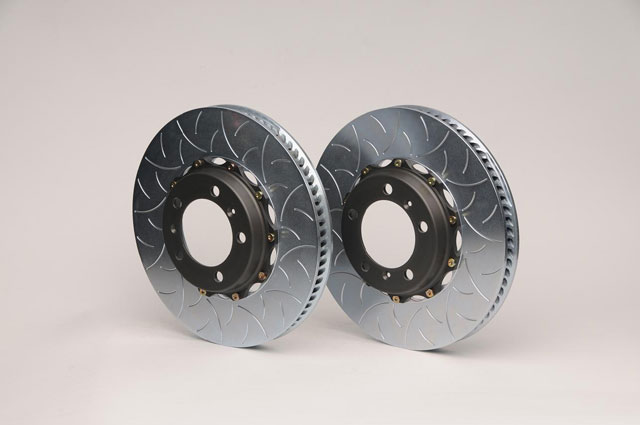
Suspension
The PASM suspension on the 2009+ Carrera is much improved over the previous 997 cars, with stiffer shocks when wanted and even better compliance on rough roads in non-Sport mode. Most owners want to lower the car for aesthetic purposes or to lower the center of gravity with stiffer springs in order to help cornering performance.
Lowering Springs
Since the OEM PASM suspension works so well, we recommend the TechArt Lowering Springs for these cars. This allows the Sport button to still work as intended, lowers the car about 20 mm, and gives tighter and more resposive cornering ability. The ride quality remains very compliant. For most types of driving and in city streets with potholes and steep driveways, these springs still do a great job., The effectiveness and life of the stock shocks will not be negatively impacted since TechArt made the springs with the OEM shocks in mind.
We do not recommend other brands of lowering springs. Some tend to sit too low, others sag over time, or offer a bouncier, rougher ride quality. TechArt have a nice ride quality that allows the car to be driven as intended, be it daily or for occasional track use.
If you are also going to be sticking with stock wheels with stock offsets note that a lowered ride height will also cause the wheels to look more "tucked" in. Quite often a fix is to use a wheel spacer to "push" the wheel back outward towards the fender. You can view a selection of our wheel spacer kits here. For example with a TechArt spring kit we usually recommend a 7mm in front and 15mm in the rear.

Coilover Suspension
The Bilstein Damptronic PASM Coilover kit (adjustable Springs and Shocks), which is commonly installed on PASM equipped 997 models, was not updated for the new DFI 997.2 Carrera S. Since the OEM system was updated, it seems like a bad move to "upgrade" to the older Bilstein kit, especially considering most people simply want to lower their car. For more track themed 997.2 where disabling PASM is an option we have used the Ohlins Road & Track Coil Over System. With an adjustable ride height and dampening level these are still compliant on the street as well as more tactile for the track.
At this point we do not recommend other coilover kits for these cars as well: among the options available on the market, no other works better for the street than the TechArt springs from what we've found, and most are designed for racing applications (e.g. Ohlins or Moton). Unless you are building a full time dedicated track car, the extra adjustability of these coilover kits would likely be wasted, and the drawback of losing the PASM functionality and having a rougher ride on the street would somewhat ruin the point of this great street car.
The standard suspension (on non-S models) is still an improvement over previous non-S cars, and we recommend changing the springs before jumping to coilovers. However, the Bilstein coilover suspension kits for the non-S are slightly better than on the S models since PASM is not used.
Suspension Links and Toe-Steer
The upper rear suspension links (2 per side, 4 per car) on all 997 models feature neoprene bushings and are non-adjustable in length. The RSS variant adjustable links provide a long lasting, quiet solution to both of these problems by giving adjustable length and monoball bushings on either end. These bushings stiffen up the handling and feedback on the car, giving quicker handling response and more direct results when you turn the car. The adjustable length helps to set the alignment to factory or race specs on modified cars.
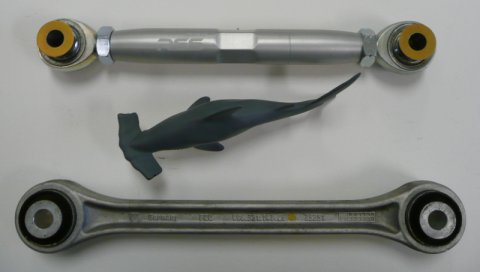
One other issue with the rear suspension is the toe-steer link, that directs the toe-in/out angle of the rear wheels under cornering. The RSS replacement Toe-Steer kit also includes a monoball inner bushing, giving further tightened handling and feedback as it replaces another neoprene bushing. The length is adjustable for toe adjustment on the alignment beyond factory and the locking plates ensure that the toe-angle does not swivel and change as the suspension arm travels up and down with bumps, unlike the factory piece.
Control Arms, Thrust Arm Bushings, Pivot Bushings
If you plan to track the car often, you will most likely want to adjust the rear negative camber and will want adjustable control arms in the front and rear.
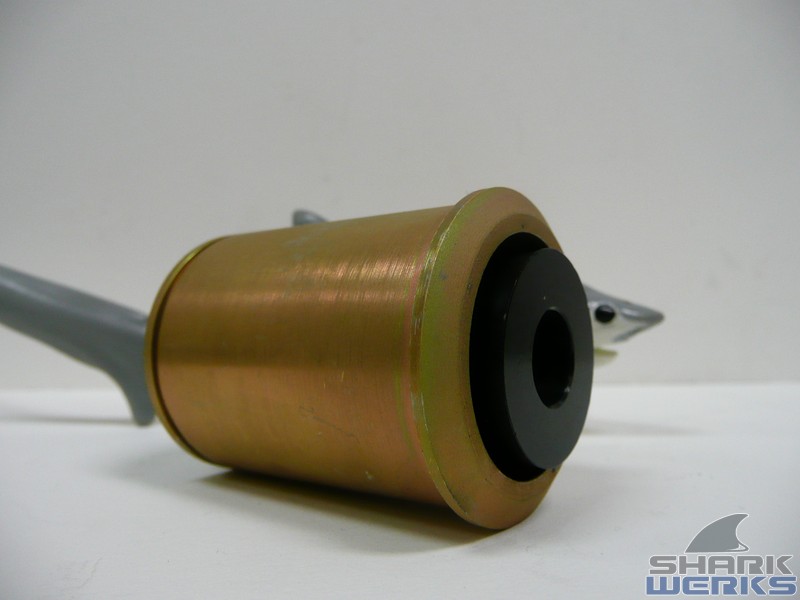
We recommend the RSS Tarmac Series Control Arms for a couple of reasons: they're actually priced better than factory GT3RS arms and they also include steel monoball pivot bushings and aluminum thrust arm bushings. The factory arms have two locations (on either end of each arm) where Porsche opted to use a neoprene bushing, to quiet and dampen the street driving. The RSS arms hold up well with mileage (we have seen some with 30,000+ miles of mixed driving now) and are very quiet despite these metal bushings.
The result is better feedback and more direct handling; a stiffer setup that won't cause headaches and back pain from extra jolts. Yes, these parts are okay for street use and it's unlikely you'll complain about the extra noise.
An alternative is to replace the neoprene bushings in your stock control arms, but the OEM arms are not split-design on these cars, meaning you cannot fully adjust the camber. And due to the labor involved and the permanent nature of this modification, we find it's better, easier and cheaper to simply swap them out.
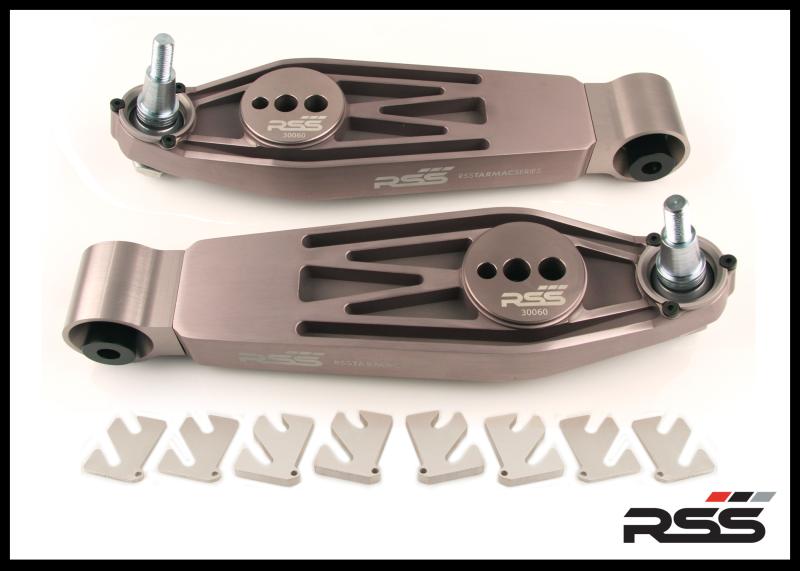
Sway Bars
The factory sway bars can be upgraded in order to reduce the body roll experienced while cornering on the 997.2. The sway bar is used to prevent the car from rolling, and a stiffer bar will stop the weight from shifting as much side-to-side (laterally) while cornering. The RSS bars are 3-way adjustable allowing you to dial in how much sway bar tension you require, to balance oversteer/understeer front-to-rear. There is no downside as far as noise or comfort lost by installing this type of part. We especially recommend this in conjuction with other parts, such as lowering springs and the links mentioned above.
Engine Mounts
The stock engine mounts are hydraulic engine mounts, and the drivetrain will move independent of the chassis during acceleration, deceleration and cornering. This movement can upset the balance of the vehicle and create negative handling effects. The RSS engine mounts minimize these effects by utilizing specialized polyurethane bushings which offer a firmer, more direct driving feel with optimum feedback. This upgrade will not adversely affect ride quality or cause knock sensor issues commonly associated with solid engine mounts.
Transmission, Shifter, PDK and Flywheel/clutch
One of the most annoying features of the PDK in standard form is the whole "button" conumdrum that Porsche decided was a better idea than having one paddle for upshifts and one for downshifts.
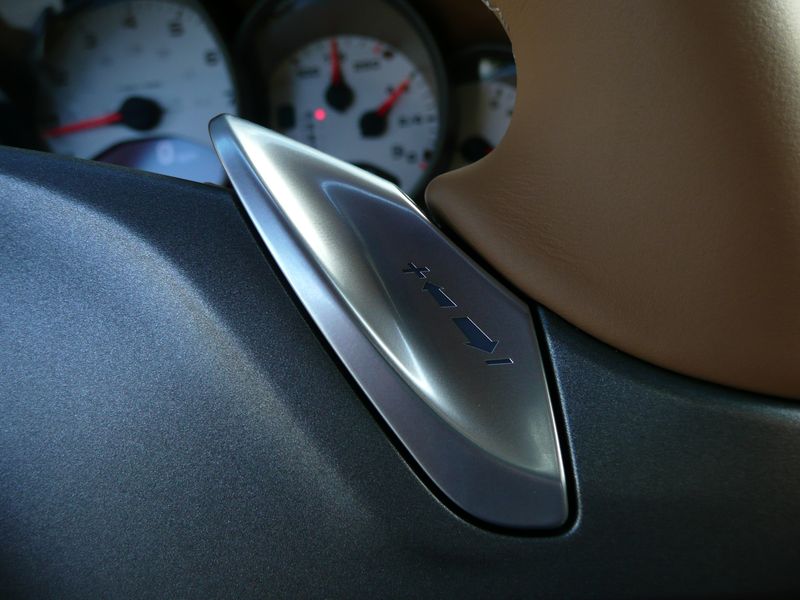
It's worked for every other car manufacturer's duoble clutch set up in the past, present and future so why did they irritate us so? On our own car we can remember multiple instances of getting ready to turn in to a corner coming in 3rd and our palm hitting the up shift button and going into 4th instead of the desired down-shift into 2nd for the tight corner. Not the sort of thing you want really. You know Ze Germans, they don't always make awful stuff but when they do...
The good news is after a year of online and press complaints they come out with a "Sport PDK" steering wheel with proper paddles for up and down shifting. It's expensive and requires a dealer-trip with a module for activation. For the rest of you there's a nice option from TechArt that retrofits your standard wheel:

For 6speed cars we highly recommend using the factory short shifter kit or the more adjustable and precise Numeric Racing shift kit (we like to set that on the middle hole). We've used both for years and it's a matter of preference but for us the improved hardware and mechanism of the Numeric as well as the ability to adjust the throw gives it the nod. If shifting gears is your call then the addition of either of these two gives you less-throw and more precision. Similar to a GT3 and just how we like it. Unless you're doing a lot of track work it's unlikely you would ever break the factory shifter cables but should you need replacements Numeric Racing also has that covered. If you like the feel and throw of the factory unit it can the plastic mechanism can still wear out some and cause it to feel vague so we also use a bushing rebuild kit. Porsche sadly uses cheap plastic bushings and pivot connections utilized in the shifter assembly which wear out over time. Because these bushings require loose tolerances and free play to not bind, they generate sloppy shifter feel. Moreover, their plastic and rubber construction flexes excessively which causes spongy gear engagement, especially on cars that have accumulated wear and tear over the years. The retrofit kit is comprised of custom machined aluminum pieces, heavy-duty enclosed ball bearings, and hardware to entirely upgrade the factory shifter assembly.
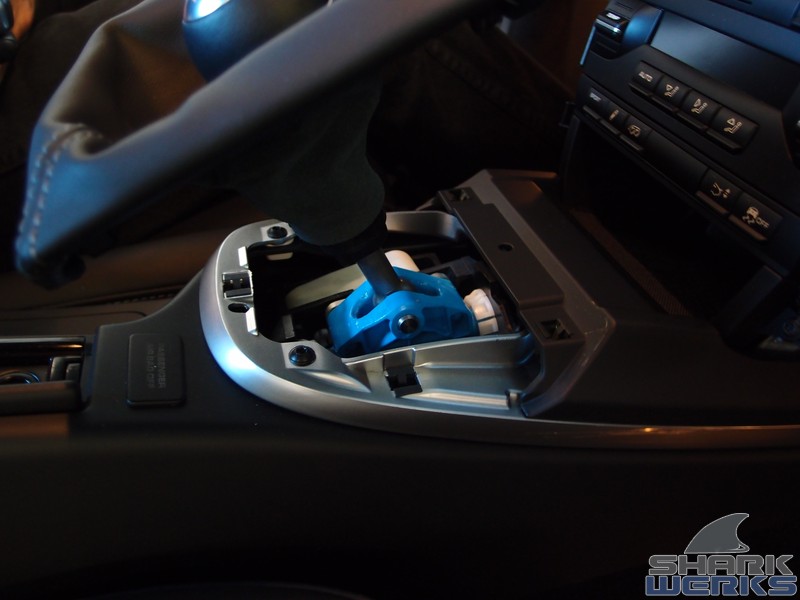
Lightweight Flywheel
For 6-speed manual equipped cars, there is one major performance upgrade that is often overlooked. The flywheel on the 997.2 (and actually all 993, 996 and 997 non-GT3 cars as well) is a dual-mass, 28-pound unit. Porsche switched to this flywheel to dampen transmission noise, but it's a heavy weight for the crankshaft to spin up and drastically affects the 0-60 MPH performance of the car. In fact, the 997 GT3RS model had a single-mass 14 pound flywheel as standard equipment, and was 3/10th of a second faster 0-60 than the regular 997 GT3, with this being the only performance difference.
Luckily there's a 14-pound replacement for quicker engine response, faster revs and more exciting downshifts. The car is more fun to drive and considerably quicker in the lower gears with this upgrade.
There's one downside, however. The transmission will make some noise whenever the vehicle is warmed up and idling. The noise can be described as "sizzle" or "rattling", and it will become silent whenever the clutch pedal is depressed. The sound is also audible when accelerating from low RPMs. Before adding this upgrade to your car, it's a good idea to hear one in person to understand the sound. If you don't mind a little extra noise, it's one of the best upgrades for straight-line performance and enhancing the driving experience. The lightweight flywheel requires the transmission to be removed to install (approximately 7-hours labor on a 2WD model), so it might save money to replace the clutch at the same time (or vice-versa).
Aerodynamics
The 911 shape is beautiful any which way you slice it and over the last 50 years its DNA still recognizable from any model. We certainly don't want to change that drastically however we can also appreciate wanting to personalize and/or giving a 997.2 a more edgy appeal. With a few subtle (and some not so subtle) body modifications that we have done both to our own 997.2S and many customer cars, there are ways to make the car look more aggressive and yet retain a factory-level fitment and indeed improve upon it aerodynamically in terms of additional down-force. We take the approach that if we are going to be adding a wing, front lip or diffuser we certainly don't want to impact the cars handling in any adverse way, which is why we only use either Porsche factory wind-tunnel tested/verified body enhancements or options from either TechArt or Werks1.
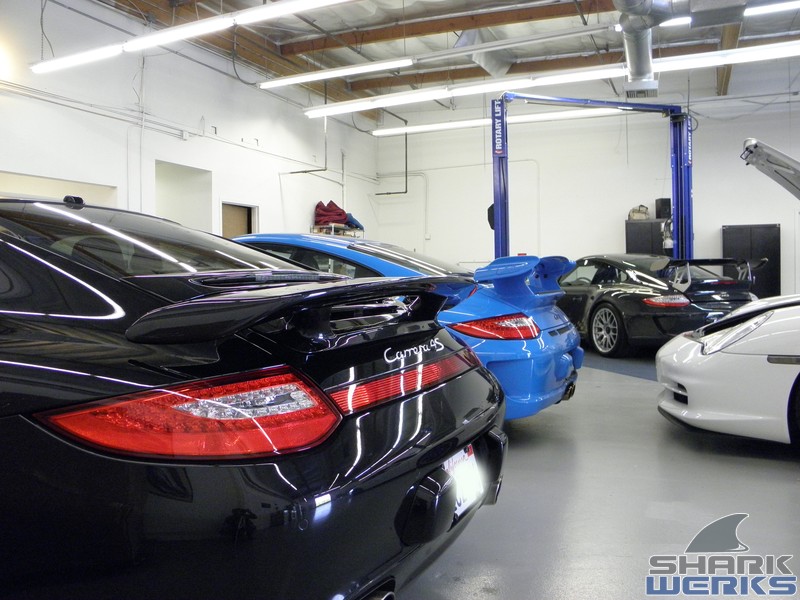
Factory Aerokit
If you didn't order your car with the Porsche Aerokit, in can be done so at a later date. The factory parts install perfectly as one would expect. The front and rear tail give the 997 Carrera more of GT3-style look/function. Some cars that were ordered with the Porsche Aerokit already should not be tampered with: they look/function fantastically as well, so why try to improve upon perfection?
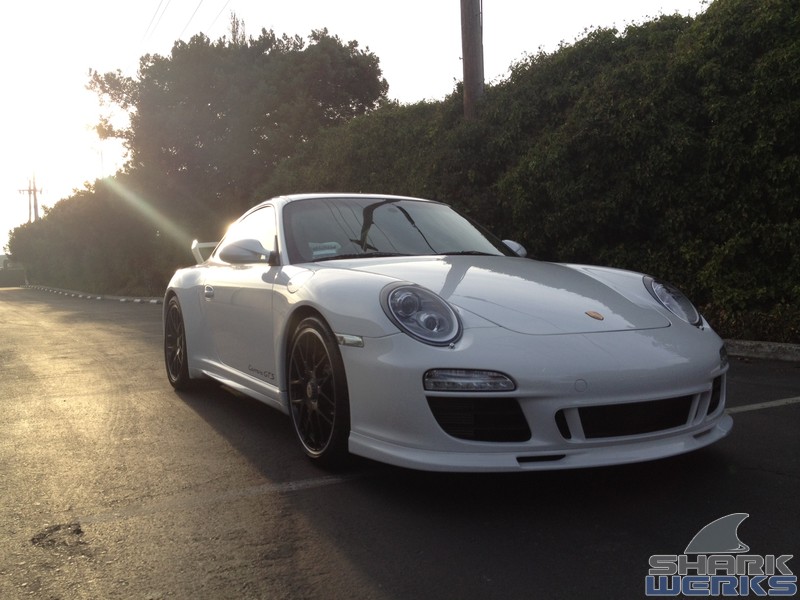
It goes without saying that if your car is a cabriolet it probably isn't a great idea to add a GT3/aerokit wing...
TechArt utilizes the very same university facility as Porsche for wind-tunnel testing, which is crucial for both safety and performance. For example, their Type 1 front lip not only reduces uplift at the front axle but does so while providing additional cooling to the brakes; form and function rolled into one. At the same time their Type II wing generates an additional 76 kilgrams of downforce over the factory wing at the rear. In other words the TechArt Aerokit I ensures well-balanced aerodynamics and improves driving stability significantly, especially at high speeds whilst looking good at the same time.
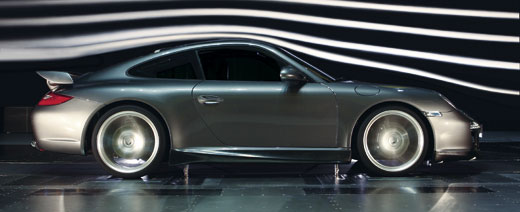
We have found the TechArt & Werks1 brand parts to be outstanding in terms of fit and finish and an ideal standard when compared to say a factory aerokit. We have tried, fitted and tested many other products over the years and have generally found a lack of proper fitment, poor quality materials and/or no verified testing which can lead to adverse affects at high speeds. Installing a fiberglass "knock-off" front bumper may seem like a cheaper alternative but remember the body shop will usually have a hell of a time making it a) fit and or b) making it blend into the rest of the car. Remember that fiberglass is generally a poor choice of material to use, especially in the front of your 911 which gets peppered with debris and can crack much more easily. This is why Porsche uses PU-RIM (Polyurethane material) style material in such areas. The reason for TechArt's long-standing quality in the industry is the amount invested into R&D, tooling and materials. Their products are developed and designed using model building, CAD (Computer Aided Design) the entirely made of high quality polyurethane RIM just like the OEM parts.
The most widely adopted path of aerodynamic enhancements by Shark Werks customers past and present starts with TechArt. Having been a contractor for Porsche's exclusive options department some 20 years ago, TechArt knows best what Porsche requires for quality, fit, material, finish and subjectively speaking, style. Rarely does a TechArt modification by itself or in total form look out of a place. In fact we were so smitten by their early 997.2 renderings/designs that in order to launch their Type 1 Aerokit we donated our ZTADPOL to assist with the launch back at the SEMA 2008 show. The car went from a standard 997S to this completely built TechArt Type 1 eye-catcher:
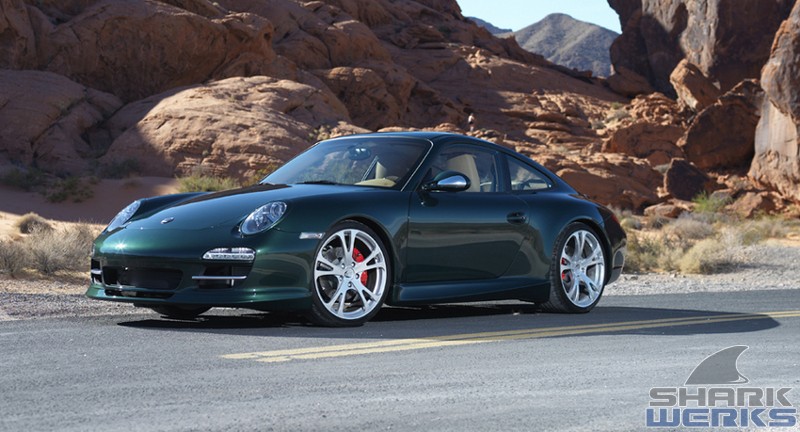
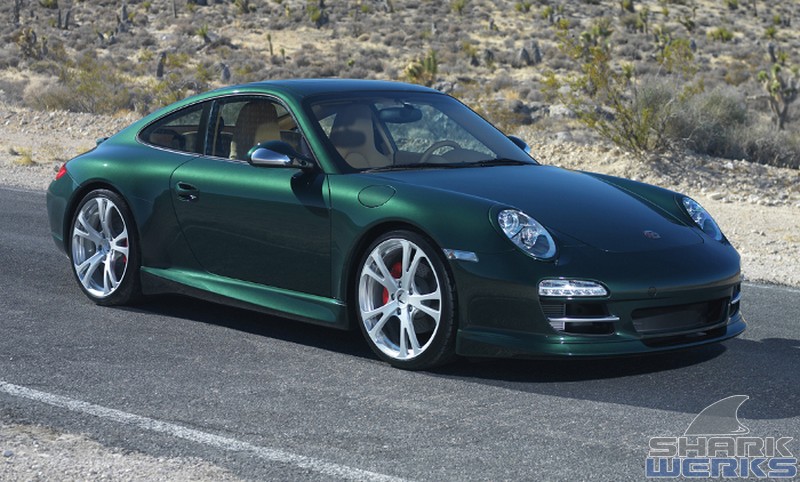
TechArt parts can be bought/used singularly or in complete form. We tend to recommend however if you're making a change to the front only it would be wise to compliment that with an equivalent rear piece to keep the intended balance (or visa versa). It's not a good idea to install a large Type IV wing in the rear with only the factory front. At high speeds you would also want to reduce lift in front for proper balance.
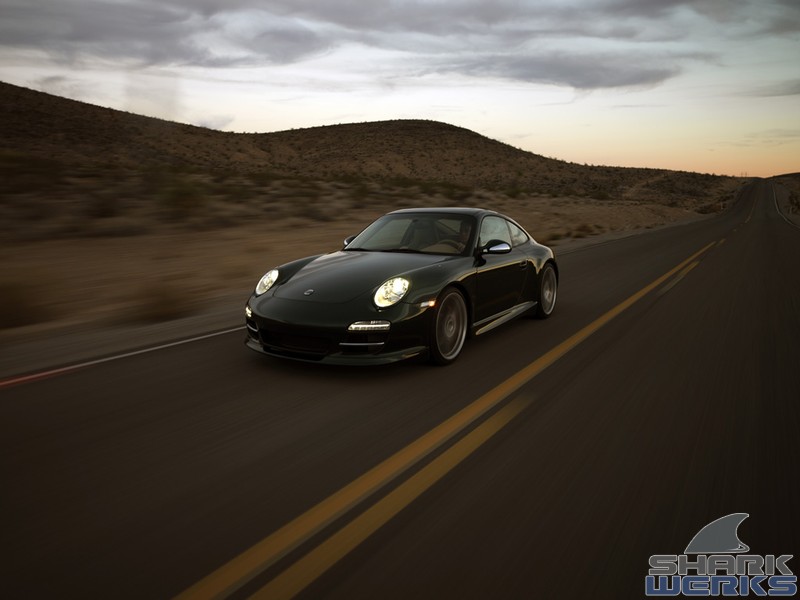
If carbon fiber is your calling, then look no further than Champion Motorsports' Werks1 division. Their high-quality carbon fiber aero enhancements have also been wind-tunnel tested and proven. The Werks1 diffuser was designed using state of the art engineering and computer modeling techniques. Using these processes, a functional prototype was created and wind tunnel tested in order to verify the effectiveness of the part. During testing, it was proven that a stock 997.2 (with wing raised) produced over 40 lbs of lift at the rear axle, at 175mph. With the rear wing raised and the new Werks1 diffuser installed, that number was completely eliminated, and the test vehicle not only showed no signs of lift, but it now produced 14 lbs of usable downforce, again at the rear axle. When measured at both the front and rear axles, the stock 997.2 showed nearly 110 lbs of total lift. Once the Werks1 diffuser was added, total lift was reduced to just below 75 lbs. Best of all, the addition of the Werks1 rear diffuser increased the vehicle's coefficient of drag (or Cd) by only .002, from .313Cd to .315Cd. What this means is that the downforce created by the Werks1 rear diffuser is essentially "free", with no negative side-effects to be found.
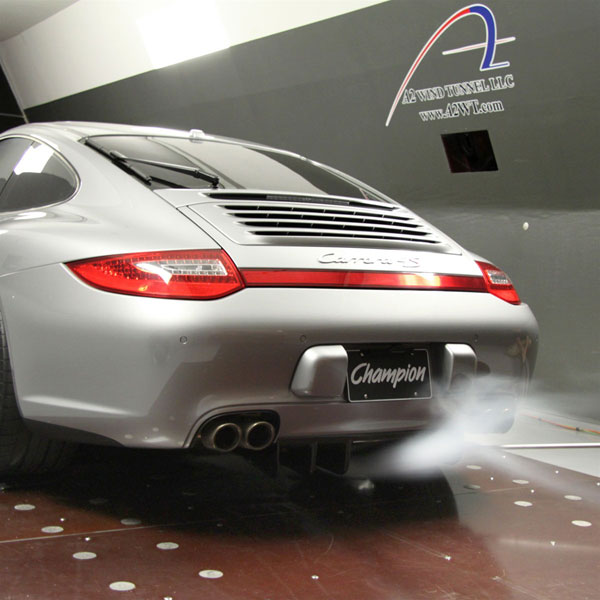
For a full list of our supported body enhancements head over to the 997.2 Aerodynamic section.
Seats, safety and track prep
For 2009 Porsche finally introduced a bucket style seat that was available in regular 911's. If you intend on tracking your 997.2 we highly recommend getting a car that already has these slick, lighter carbon fiber back seats pre-installed. Otherwise you're going to be looking at an $8000 price of entry in order to retrofit a set. Sport adaptive, Sport of regular seats are fine for occasional driver's education style events but you will not be able to properly install a 6-point restraint system.
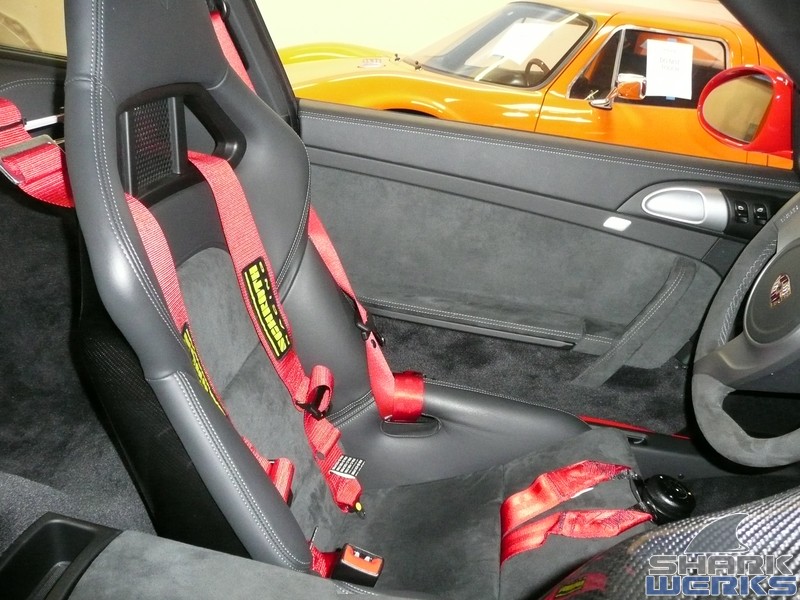
The 996 GT3 Euro seat makes for a worthy and cheaper factory alternative if you can find it:

For more serious track work, look into Recaro/Sparco alternatives. Be sure to get the correct bracket/hardware and leave enough clearance for your head and helmet with its sunroof robbing you of an inch or two. Again if you're going this route you will need to remove your rear seats, install a roll bar of some sort and generally desensitize the car for street duty. It begs the question if you need/should move to a GT3?
Should you need/want to install 6point harnesses, we recommend Schroth Profil II pull-down with HANS capability. Also remember to plan on a good solution for the sub belt - we suggest either using the factory 996 GT3 sub belt bracket, or a Brey Krause alternative and/or eye-bolts in the chassis. It is possible to import the factory Tequipment roll bar.

In the US it's much easier to go with after-market bolt-in roll bars such as the 901 one which does not require the removal of your sub woofer unit we use from RSS. A starter or analogue of the factory Tequipment bar is the 901 shown below:
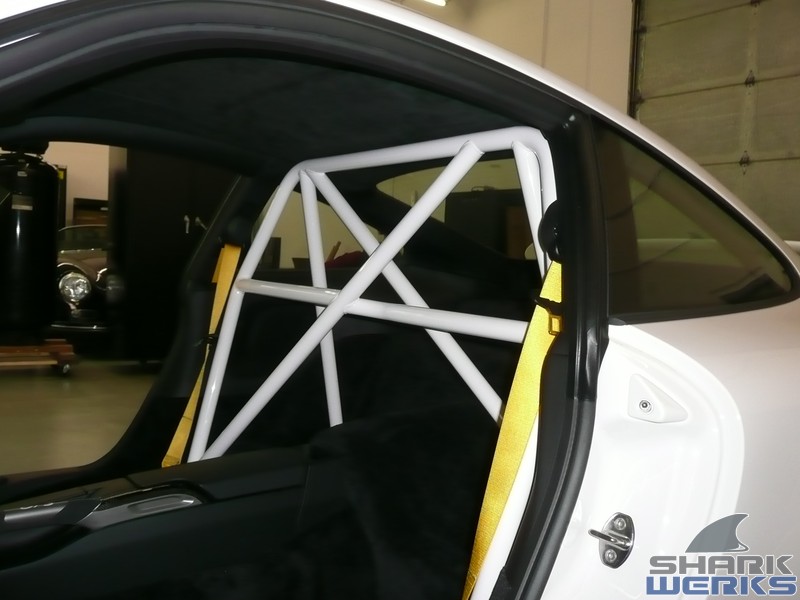
If you are set on removing the sub woofer a more sturdy option is the 930 which bolts into the strut tops at the rear of the car (an improvement over the Tequipment). There is also a more serious Chromoly made weld-in option in the form of the extra-braced 931.
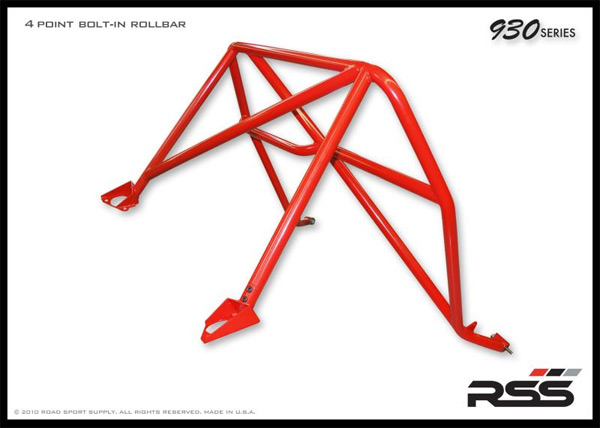
It's important to remember that none of these solutions are welded in nor do they provide the same level of safety as a professionally built and structurally improved full roll cage. If you intend on more serious track events or club racing, then we suggest finding an experienced cage builder. In our area we use TC Design for example.
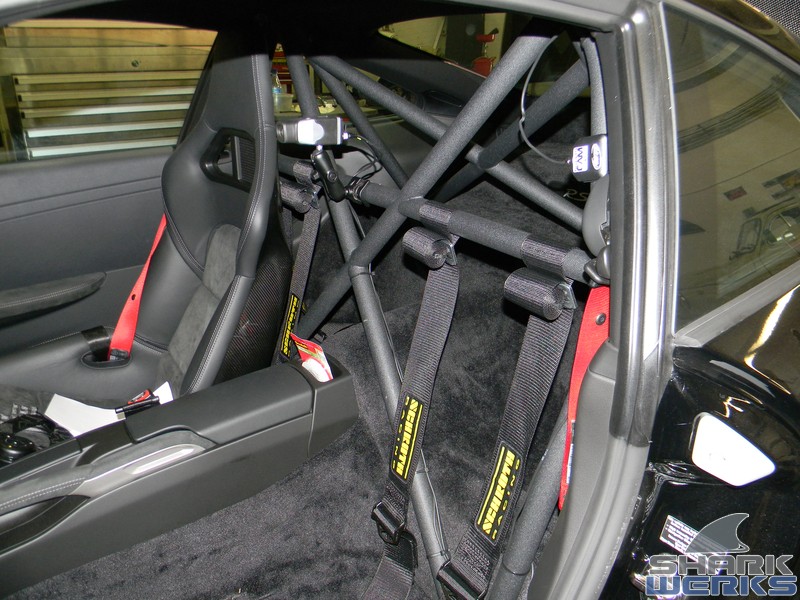
These are usually welded to the chassis and do not have the points bolted into seat belt mounts etc... that could sheer. More serious track nuts tend to refer to these "bolt-in" roll bars as "jewelry" or "glorified harness bars". For driver's education they do the job just fine though.
For those of you that do not want to have a roll-bar you can actually use a Brey Krause harness bar which is easily removable and less intrusive.
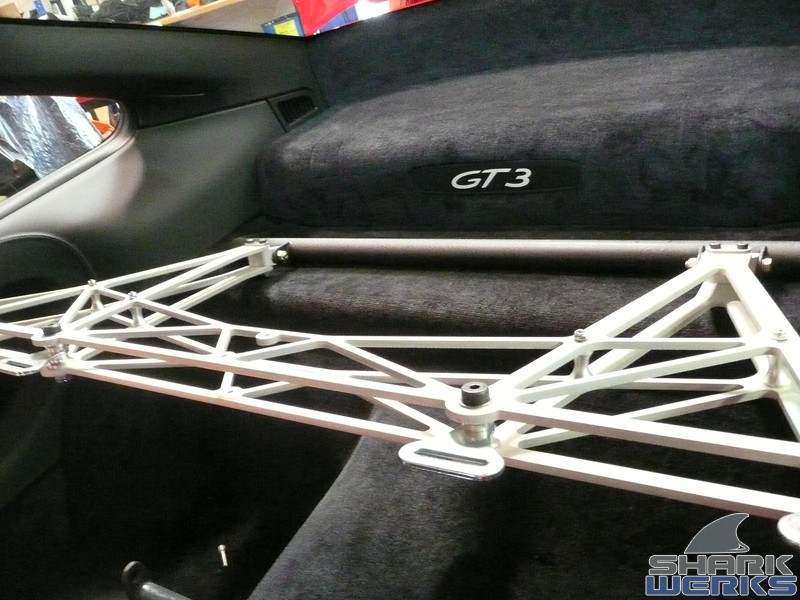
Interior
For 2009 Porsche revamped the interior to include a much-improved PCM 3.0 so now all your BlueTooth and iPod concerns are addressed (finally). The interior is certainly all business-like and we're not a huge fan of "redecorating" something that already functions so well.

Having said that it can be fun to add some character with either a few painted interior pieces (such as the rear main center console) or replacement carbon fiber pieces. Both are offered from the factory but expensive!
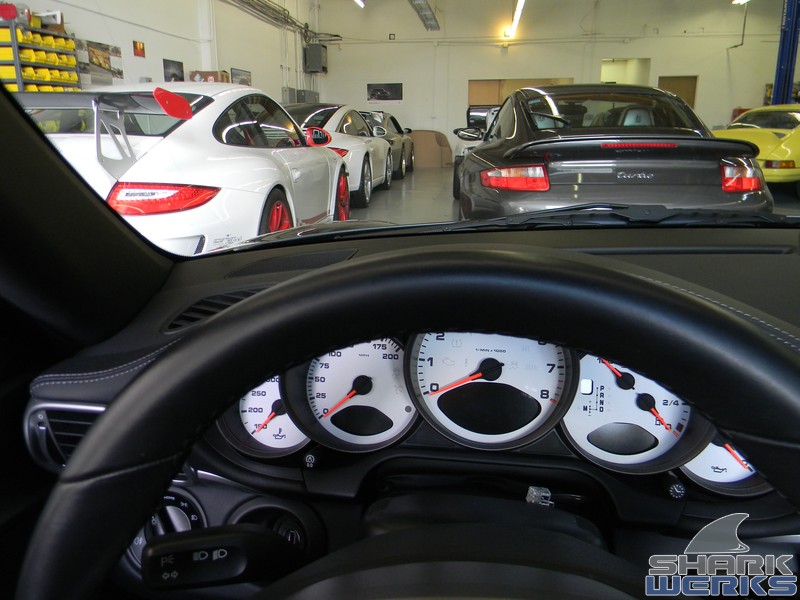
The 997.2 was/is great swan song for Porsche. It corrected many of the mistakes/mis-steps of the 996/997 era and was much-improved platform both in terms of engineering and function. Quite frankly our '09 car with its modified suspension, TechArt aero, EVOMSit tuning, PDK, SharkWerks exhaust et al was perhaps the best daily driver we've ever had. You could throw any situation at it and the car dealt with it with much aplomb. In stock form the car was a little sedate but by pulling at it here and there one can give it more edge, power, sound and performance.
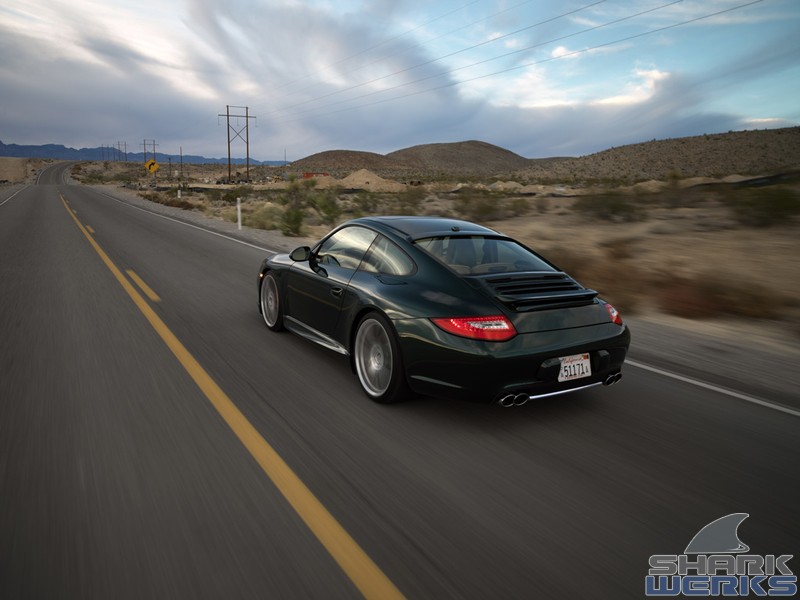
SharkWerks Recommends (for Street Use)
- SharkWerks Bypass Exhaust
- EVOMSit Software
- TechArt Lowering Springs
- Toe-steer kit & locking plates
- Adjustable rear links
- Adjustable Sway Bars H&R or Eibach
- Lightweight Flywheel & Numeric Shifter (for 6-Speed transmission only)
SharkWerks Recommends (for Track Use)
- Consider upgrade to the GT3 model instead
- SharkWerks Bypass Exhaust
- EVOMSit Software
- TechArt Lowering Springs
- RSS Tarmac Series Control Arms (front and rear)
- Toe-steer kit & locking plates
- Adjustable rear links
- Adjustable Sway Bars H&R or Eibach
- Lightweight Flywheel & Numeric Shifter (for 6-Speed transmission only)
- Harness bar & safety harnesses
- 3rd / center radiator upgrade to reduce temperatures
- Zinc-based racing oil such as Mobil 1 Synthetic Racing Oil
Items we would NOT recommend changing
- Intake
- Headers / Catalytic converters
- Transmission
- OEM Oil cooler and oil system
Recommended Forums & Links
Rennlist.com - An active forum for 997.2 owners with some owners tracking their cars.
6SpeedOnline.com - A great site for street enthusiasts and beginners to the 997.2
Teamspeed - This forum has a wide audience including international owners and many news stories about upcoming 911 models
